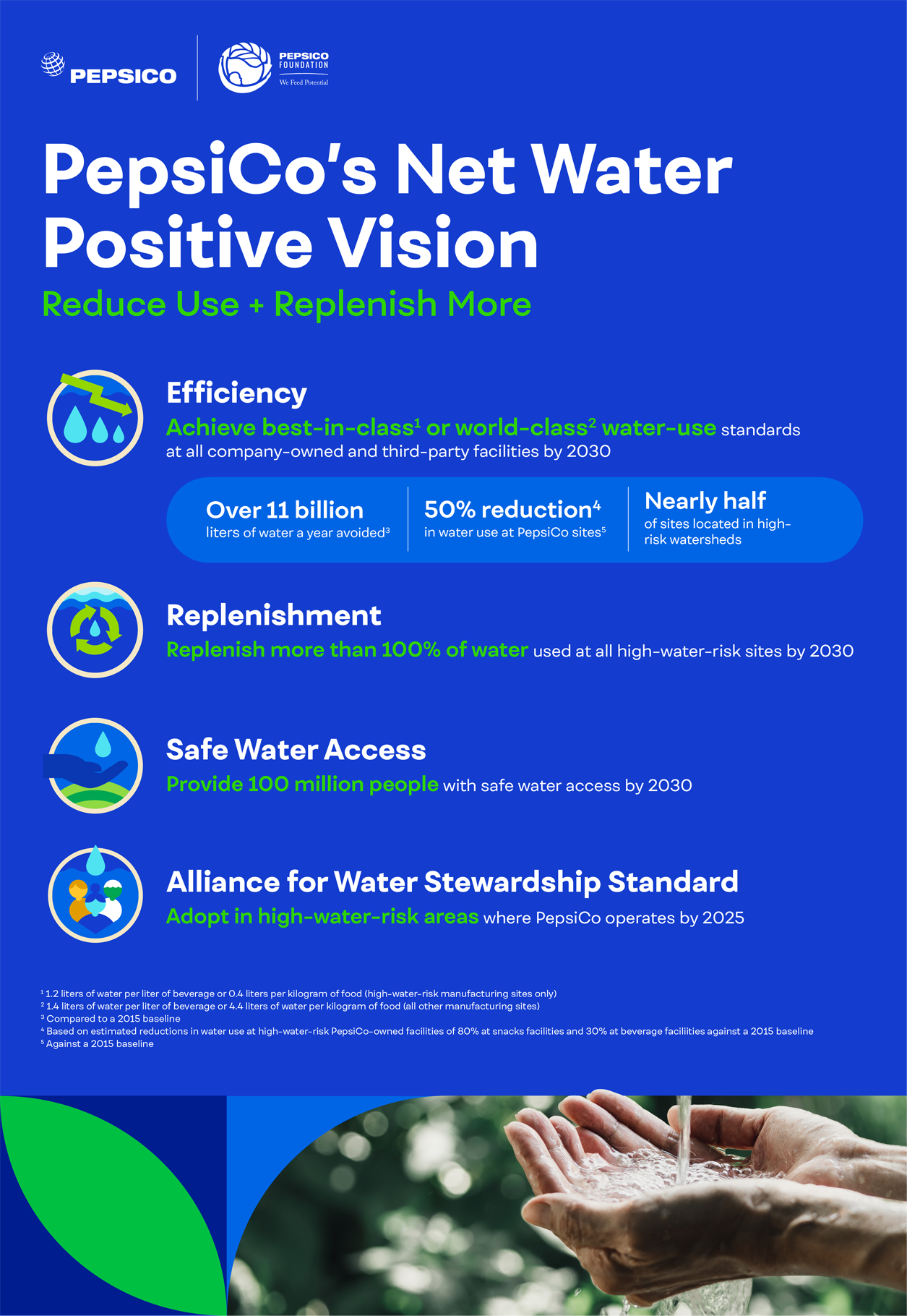Washing potatoes before they get sliced up and cooked into chips requires water. But now, PepsiCo’s Sabritas Vallejo plant in Mexico City is getting more out of every drop, thanks to an innovative idea: It washes those potatoes with the same water
used in its bottling partner’s beverage manufacturing process, after it’s been treated to safe-drinking standards.
The impact: A single facility decreased its freshwater demand by more than 50% in 2020 versus 2019 — and set an example for others to follow.
This is just one of many creative ideas PepsiCo is implementing as it aims to become Net Water Positive — that is, replenishing more water than the company uses and achieving best-in-class water-use efficiency at its manufacturing facilities in
high-risk watersheds (land areas that channel rainfall to larger bodies of water). Only 3% of the world’s water is freshwater, and PepsiCo’s vision is that, wherever in the world it operates, water resources will be in a better state because
of its presence.
Such efforts stand to make a meaningful difference — and set PepsiCo apart not only in the food and beverage industry, but also among corporations at large. PepsiCo aims to raise efficiency standards at nearly 100 company-owned food and beverage
facilities in high-risk watersheds and to work with franchise bottlers and third party manufacturers to do the same. Doing so could save more than 11 billion liters of water per year in PepsiCo-owned operations alone.
“Time is running out for the world to act on water," says Jim Andrew, PepsiCo's Chief Sustainability Officer. "We believe a global effort to be net water positive is essential."
We believe a global effort to be net water positive is essential.
With its long-term aims of supporting water security for its business, natural ecosystems and local communities, PepsiCo has established four key Net Water Positive goals driving its action:
- Improve water-use efficiency at all company-owned and third-party manufacturing facilities by 2030. PepsiCo has set two key water-use standards: “best-in-class” for facilities in high-risk watersheds and “world-class”
for all others. (“Best-in-class” translates to using 1.2 liters of water per liter of beverage, or 0.4 liters of water per kilogram of food; “world-class,” to using 1.4 liters of water per liter of beverage, or 4.4 liters
of water per kilogram of food.) This goal will raise PepsiCo’s direct operational water-use efficiency by 50% by 2030 in high water-risk areas (against a 2015 baseline). The company also aims to improve its direct agricultural supply chain
water-use efficiency by 15% by 2025 (against a 2015 baseline). As of 2020, PepsiCo already achieved 14% of this goal.
- Replenish more than 100% of water used back into local high-risk watersheds by 2030. PepsiCo’s goal is to put back more water than it uses from these watersheds through investing in water conservation partnerships with local
stakeholders. The company is deploying a range of initiatives to accomplish this, such as investing more than $1.5 million in an Arbor Day Foundation project to restore forests that burned during California’s 2018 wildfires. The Arbor Day
Foundation aims to plant more than 880,000 trees, which will help prevent erosion, keep water clean and lead to the replenishment of 458 million gallons of water per year by 2022.
- Provide safe water access to 100 million people by 2030. Thanks to the efforts of The PepsiCo Foundation, the company is already more than halfway to reaching this goal, having helped more than 59 million people gain access to safe
water through distribution, purification and conservation programs over the past 15 years. Today, The PepsiCo Foundation launches a $1 million program with NGO and long-term partner WaterAid to bring safe water to families in Sub-Saharan Africa,
helping combat the impacts of the COVID-19 pandemic.
- Adopt the Alliance for Water Stewardship (AWS) Standard in high water-risk areas by 2025. The AWS Standard creates a framework for collaboration between companies, governments and local communities, helping them find opportunities
for sustainable water management and improved water governance. Since piloting the Standard at PepsiCo’s snacks plant in Sundar, Pakistan in 2019, the site has improved its water-use efficiency by 30% and replenished 10 million liters of
water — thereby directly benefitting 55,000 people.
“We’re focused not only on making sure people around the world have access to this vital resource, but ensuring that we are also prioritizing water stewardship in our operations everywhere," says Andrew. "Water is not only a critical component
of our food system, it is a fundamental human right.”
